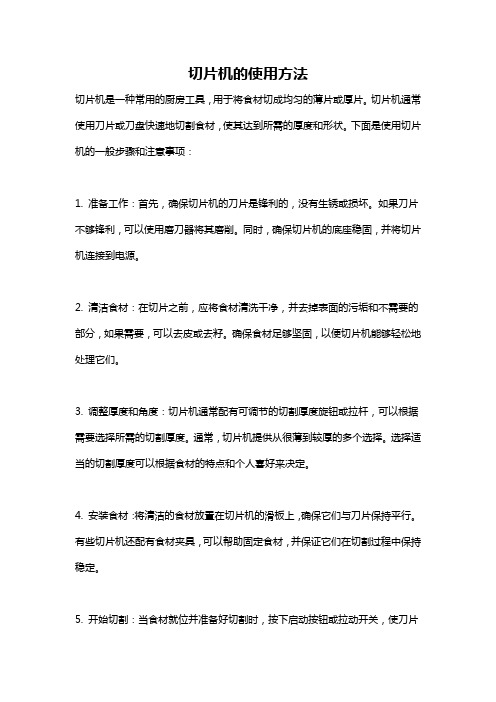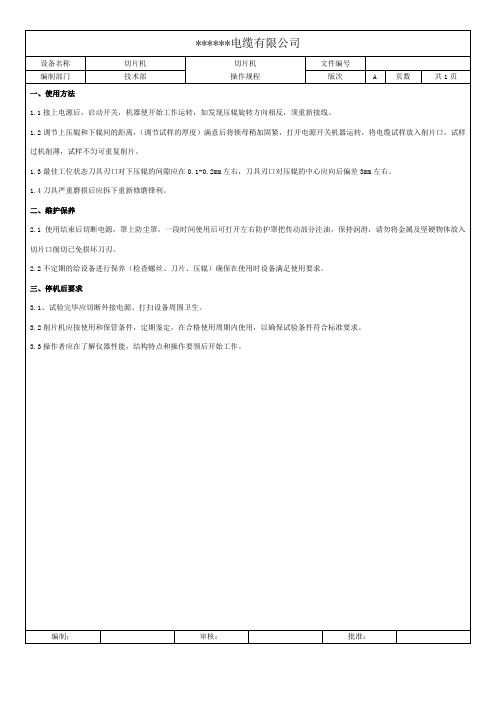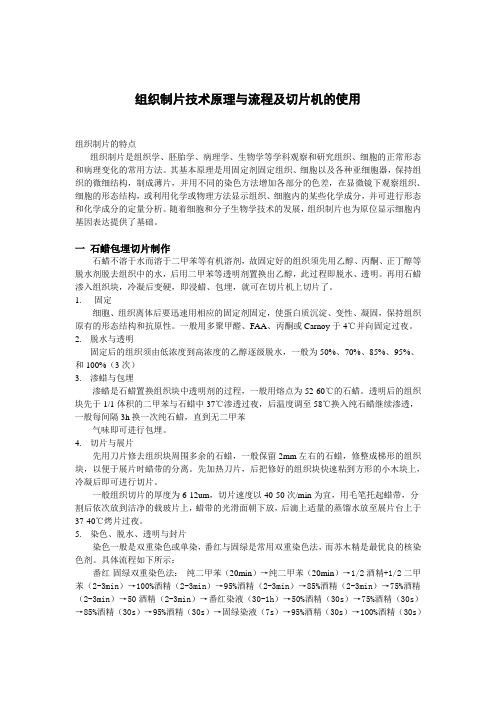样品切片制备技巧-切片机进刀角度
切片机使用基本技术

指导教师:刘 艳
2014年6月
在显微镜下研究生物体的内部结构,自然状态下是无 法观察的,因为整个动、植物体大部分都是不透明的 ,不能直接在显微镜下观察,一定要经过特殊的处理 ,使要观察的材料先减少它的厚度和体积,使光线能 透过才能用显微镜观察。为了能切出薄片,必须先使 所切材料有一定的软硬度。一些包埋剂可以达到这个 目的,如石蜡,它融化时可渗入到组织内部;凝固时 ,使整个组织有一定的软硬度,正好能切出很薄的切 片,故称为石蜡包埋切片法。另外还有火棉胶包埋切 片法(火棉胶做包埋剂)、冰冻切片法(使组织冷冻 到一定的硬度)等。其中最常用的切片方法还是石蜡 包埋切片法,我们这里重点讲授切片机的使用。
切片机是制作供显微镜观察用的 切片的装置。 切片机是切制薄而均匀组织片的 机械,组织用坚硬的石蜡或其他 物质支持,每切一次借切片厚度 器自动向前(向刀的方向)推进 所需距离,厚度器的梯度通常为1 微米。切制石蜡包埋的组织时, 由于与前一张切片的蜡边粘着, 而制成多张切片的验台上,将活动快摇到最高位置,锁 定手轮。 2.将标本放置所需位置,转动标本夹的夹紧手柄,夹紧标本 3.顺时针转动松开蜡块固定器锁紧扳手,调节已装好标本的面( 通过调整竖直、水平旋钮) 4.逆时针转动蜡块固定器锁紧扳手,锁紧标本夹 5.逆时针转动左右两个切片刀固定旋钮,使其推出 6.松开切片刀倾斜角度调整扳手 7.握住切片刀的刀背,刀刃朝上,小心从侧面插入刀架 8.顺时针旋转刀片固定旋钮,均匀的抵住刀片,先不顶紧 9.移动刀片倾斜角度调整扳手,调节切片刀后角质所需位置, 然后拧紧切片刀倾斜角度调整扳手螺栓。
10.顺时针旋转刀片固定旋钮,均匀夹紧切片刀 11.拉出手轮停止旋转手柄松开标本夹,转动手轮将标本摇至 切片刀相对的位置 12.松开离合器,移动刀架使刀刃靠近标本,而后锁紧离合器 13.转动切片厚薄粗调器,调节标本至恰好与切片刀相遇。与 此同时转动手轮使标本上下移动,并观察标本与刀刃的距离, 同时将标本蜡块修平 14.转动切片厚薄调节器至所需厚度,回转手轮试切标本直至 所理想的标本面 15.通过转动切片厚薄调节器将切片厚度调节至所需值 16.转动手轮均匀切片 17.取片至标本
切片机的使用方法

切片机的使用方法切片机是一种常用的厨房工具,用于将食材切成均匀的薄片或厚片。
切片机通常使用刀片或刀盘快速地切割食材,使其达到所需的厚度和形状。
下面是使用切片机的一般步骤和注意事项:1. 准备工作:首先,确保切片机的刀片是锋利的,没有生锈或损坏。
如果刀片不够锋利,可以使用磨刀器将其磨削。
同时,确保切片机的底座稳固,并将切片机连接到电源。
2. 清洁食材:在切片之前,应将食材清洗干净,并去掉表面的污垢和不需要的部分,如果需要,可以去皮或去籽。
确保食材足够坚固,以便切片机能够轻松地处理它们。
3. 调整厚度和角度:切片机通常配有可调节的切割厚度旋钮或拉杆,可以根据需要选择所需的切割厚度。
通常,切片机提供从很薄到较厚的多个选择。
选择适当的切割厚度可以根据食材的特点和个人喜好来决定。
4. 安装食材:将清洁的食材放置在切片机的滑板上,确保它们与刀片保持平行。
有些切片机还配有食材夹具,可以帮助固定食材,并保证它们在切割过程中保持稳定。
5. 开始切割:当食材就位并准备好切割时,按下启动按钮或拉动开关,使刀片开始运转。
慢慢地推动滑板,让切片机的刀片切割通过食材。
确保用手指远离刀片区域,以免发生意外伤害。
6. 注意安全:在使用切片机之前,务必阅读并理解切片机的使用说明书。
切片机的刀片非常锋利,使用时要特别小心。
应使用切片机时戴上手套,以保护手指不被刀片割伤。
7. 清洁和维护:在使用切片机之后,应立即将其断开电源,并清除食材残渣和污垢。
可以使用温水和中性洗涤剂清洗刀片、滑板和其他可拆卸零部件。
注意不要用太热的水清洗刀片,以免造成变形或损坏。
确保彻底清洁和干燥切片机的各个部分,以防止细菌滋生。
8. 定期检查和维修:定期检查切片机的刀片是否需要更换或磨刀,确保它们足够锋利。
如果发现刀片损坏或变钝,应及时更换。
此外,确保切片机的电线没有断裂或损坏,并定期检查电源插头和插座是否正常工作。
总而言之,使用切片机可以提高食材的切割效率和均匀度,但在使用时应格外小心,遵循安全操作规程,并注意清洁和维护切片机的各个部分。
切片机的操作规程切片机的原理

切片机的操作规程切片机的原理切片机的操作规程切片机的原理切片机的操作规程利用主机右侧的开关开启电源,用箱体温度设置按钮将切片机温度设置到切片所需温度,当设置温度时温度显示窗口显示设置温度,设置停止5秒后显示实际温度。
只要按下箱体温度设置按钮,即可随时检查设置温度。
样品头温度设置按同样方法进行。
切片时将样品放到样品托上,利用包埋剂固定,放到冷台上冷冻,在即将完全冷透前用热交换装置压平。
将冷却透的样品放到样品头上,设置样品头温度,用样品快进按钮将样品移近刀口,调整要切的平面,利用慢进按钮开始修片,修好后即可放下防卷板切片,如有需要可调节防卷板的上下位置,使切出的样品平整的进入防卷板与刀片的狭缝,取出后染色观察。
当停机时,应将玻璃窗打开,再次开机前应先检查切片机内是否有水,如有应吹干后再开机,并取出隔板检查切片机箱体底部是否有水,如有需拔开底部的塞子,将水排除,吹干后再开机。
禁止随意乱接乱拉电线,防止水溅到电源上。
切片机的原理切片机是切制薄而均匀组织片的机械,切片机的种类繁多,适用于不同领域的切片机用途不尽相同。
其工作原理是通过利用切片机锋利的切面,将物体按比例切成相应长度和宽度。
在造纸行业适用鼓式切片机,刀盘式切片机,螺旋切片机等。
其中刀盘式切片机由刀盘、机壳、喂料槽以及传动装置等部分组成,工作原理是利用沉重的刀盘起到飞轮的作用,稳定切片。
冲剂等药品,其颗粒的形成离不开切片机,这种切片机由导条板、加压辊、喂入辊、旋转刀盘组成。
工作原理是:利用刀盘由无级变速器传动,喂入辊由刀盘通过一组变换齿轮传动,而刀盘按切粒尺寸装有多把刀片。
可以自行调换变换齿轮可改变切断长度和无级变速器可改变带条的惟入速度。
试验中要处理细胞或者组织,从而方便用显微镜进行观察实验。
用于光学显微镜的有旋转式和滑走式切片机,用于电子显微镜的有超薄切片机,使用玻璃刀或钻石刀制作超薄切片。
切片机操作规程

1.4刀具严重磨损后应拆下重新修磨锋利。
二、维护保养
2.1使用结束后切断电源,罩上防尘罩,一段时间使用后可打开左右防护罩把传动部分注油,保持润滑,请勿将金属及坚硬物体放入切片口削切已免损坏刀刃。
******电缆有限公司
设备名称切片机切ຫໍສະໝຸດ 机操作规程文件编号
编制部门
技术部
版次
A
页数
共1页
一、使用方法
1.1接上电源后,启动开关,机器便开始工作运转,如发现压辊旋转方向相反,须重新接线。
1.2调节上压辊和下辊间的距离,(调节试样的厚度)满意后将锁母稍加固紧,打开电源开关机器运转,将电缆试样放入削片口,试样过机削薄,试样不匀可重复削片。
2.2不定期的给设备进行保养(检查螺丝、刀片、压辊)确保在使用时设备满足使用要求。
三、停机后要求
3.1、试验完毕应切断外接电源、打扫设备周围卫生。
3.2削片机应按使用和保管条件,定期鉴定,在合格使用周期内使用,以确保试验条件符合标准要求。
3.3操作者应在了解仪器性能,结构特点和操作要领后开始工作。
编制:
审核:
批准:
切片机的技术参数如下

一、切片机的技术参数如下:1、封闭罩壳;手动式轮转控制;2、样品夹可任意调节,样品最大值不少于3×5CM(高×宽)。
3★可加配钢刀刀座,并能一次性刀片和钢刀同时使用。
4、切片厚度能达到1—60um,并可在此范围内任意调节。
二、恒温摊片烤片机的技术参数如下:1摊片机设有水底透光装置,方便观察切片拉直、摊展状态;2★烤片时,载物片能呈600C斜插角盛放,烘片托盘能随距离而逐渐升温,保证烘片时的温度均匀;3、摊片水温:30——850C内任意调节;4、烘片温度:30——850C内任意调节;5、烤片温度:30——850C内任意调节;6★必须具有两组定时报警功能。
7、电源:220V.三、生物组织自动脱水机的技术参数如下:1大屏幕液晶显示,全中文菜单;2、可预存10——12套程序,供选择;3、机器内安置空气内循环过滤系统,消除有害气体;4★标本保护系统,无论何种情况,都能确保标本盛放篮进入液缸保护,杜绝吊篮悬于空中,使标本风干,出现卡缸等机械故障时,标本都能回到试剂缸;5、可自由选择编程系统,可使标本从任意缸开始,到任意缸结束;6、液缸数量:不少于12个,最后3个缸必须为石蜡缸;7、延时起缸时间:1——10天内任意设定;8、每缸处理时间:1分钟——240小时内任意设定;9、温度:室温——990C内任意设定;10★起缸停留滴漏时间:1——200秒可调,减少试剂浪费;11、抖动搅拌:抖动次数可调,不少于15秒一次;12★停电后石蜡能保持融化,继续工作8个小时以上;13、15个工作日内交货;14★必须是水浴加温,加温安全可靠;15、保修一年,终身维修。
带★内容为设备先进性体现必须满足,如有一项不满足视为谈判无效,三种设备必须为同一厂家产品,方便售后服务。
非★号技术条件每条负偏离增加谈判最终总报价的20 ℅,非★号技术条件负偏离2条以上,相当于一条★号不响应即谈判无效。
大庆市中医医院2005年10月19日。
切片机操作规程(

无锡华宝切片机操作规程开车前,请将减速机加注润滑油,传动部件定期每星期加注黄油,并关注需要确认加注在轴承里面。
原始开车:1、利用刮刀调节手轮将切片机刮刀调整至合适的位置,一般为挨着切片机转鼓筒面,然后利用刮刀压板上的顶丝螺母调节刮刀,使刀片均匀一致与转鼓面接触。
(多刀式结构切片机则需调节丝杆将刀片挨上转鼓即可)2、利用后方两边手轮调节切片机片厚调节装置(调节棍)调整到合适位置,一般调整至距离转鼓面1-2mm左右,利用中间两个手轮将调节棍支撑加固。
(长度1800 以下无)3、利用切片机侧面手轮调整侧刮刀与切片机转鼓侧面的距离,打开后视窗,观察侧刮刀与转鼓侧面的距离,一般调整至2mm距离。
(无法观测的情况下,保持侧刮刀松弛)4、打开切片机控制柜总电源,打开切片机启动按钮,变频器面板上显示,缓慢旋动调节电位器,将面板上调节至5HZ左右,这时切片机将缓慢转动。
如控制柜不在切片机现场,原始启动时,需有人在切片机现场观察切片机转动后的情况,如出现异常,马上利用现场的启停按钮停止切片机的运行。
如一切正常,可利用通讯告知控制柜操作人员将切片机转速继续缓慢提升,提升至10HZ后,保持这个转速空载运行(15分钟左右)。
正常调试:1、首先将切片机上蒸汽出口阀(料槽夹套蒸汽出口阀和调节棍出口阀)和冷却水出口阀全开。
2、打开冷却水进出阀,继而打开冷却水出水管道泵。
(适用于喷淋结构的转鼓切片机,其他结构打开出口阀即可)3、缓慢打开蒸汽进口阀(料槽夹套蒸汽进口阀和调节棍进口阀),不需要全开,开到适当位置。
4、打开切片机启动按钮,这时切片机转速在10HZ左右(原始开车时,已将切片机调整至该转速)。
5、在切片机出料口出安装好包装袋。
始终打开切片机溢流口阀门,下接料筒。
保持放料口的关闭状态。
6、打开进料阀,缓慢将料液流入料槽,观察视镜等待料液与转鼓接触,接触后切片正是开始,然后控制进料阀,让料液保持在视镜中间位置。
切片机保持顺利切片。
切片过程中有哪些要领及注意事项

切片过程中有哪些要领及注意事项
1. 哎呀,切片的时候可一定要注意刀要锋利呀!就像你削铅笔,要是刀不利,那得多费劲呀!比如说切肉,刀不锋利怎么能切得又快又好呢?
2. 切片的角度也超级重要好不好!这就好比投篮的角度,角度对了才能投进呀!你想想,要是角度不对,切出来的东西不就奇形怪状啦?
3. 还有啊,力度的把握得刚刚好呀!不能太轻也不能太重,这就跟打乒乓球控制力度一样,不然怎么能打出好球呢?比如切蛋糕,用力过猛岂不是把蛋糕都弄烂了。
4. 切片的时候手可得稳住喽!这就和走钢丝一样,手不稳那可不行呀!不然切出来的片厚一片薄的,多难看呀!
5. 别忘了根据要切的东西选择合适的工具呀!难道切面包和切骨头能用一样的刀吗?这不是乱来嘛!就像画画得选对画笔一样。
6. 切片的速度也得掌握好呀!太快了容易出错,太慢了又没效率,这和跑步的节奏不是一个道理吗?好比切水果,速度不合适可能就切得不好啦。
7. 注意安全呀,这可太重要啦!别切到自己的手呀,那得多疼呀!就像你开车要系安全带一样重要。
8. 最后呀,一定要有耐心呀!别急急忙忙的,耐心才能切出完美的片呀!这和绣花一样,着急能绣好吗?
总之,切片可不是随随便便就能做好的事,一定要注意这些要领和注意事项呀!。
切片规范

切片操作规范一、切片前的准备工作每天切片之前应先检查切片机的角度并将其调整固定,即刀座的角度约在10°,夹具的上下二边与刀刃平行,左右二边与刀刃垂直。
预备切片和正式切片过程中所有角度均保持一致不得随意变动。
(一)、标准切片平面调节步骤:1.将标准蜡块放入切片机蜡块的夹头中,松开锁定旋钮,把Y轴旋钮最大限度地松开,使蜡块夹头的位置尽量向前倾斜。
2.按下切片机右手边的手轮,缓缓地下降蜡块夹头,使蜡块夹头的位置刚好接近于刀刃。
3.仔细地左右调节X轴旋钮,使夹头与刀刃接近平行。
4.转动手轮将夹头抬高到最高位置,仔细地前后转动Y轴旋钮,使夹头与刀刃形成的切削平面接近垂直。
至此,标准切削平面即调整完成。
(二)标准空白蜡块制备步骤1.将不锈钢模型注入蜡液后置于热台上,液面刚好与模型的上缘平齐,不得低于或高于此限。
2.在模型底部亚萍置入组织,盖上包埋盒注上蜡液,约过10-15s,包埋盒与模型周边的蜡液凝固后,再次补充注入少许蜡液,以增加包埋盒的稳固性。
3.液面高度不得高于包埋盒上缘,加盖包埋盒时一定要保持与模型底部平面平行,无前后左右倾斜的现象。
用毛刷把切片机夹头中的石蜡残渣清除干净。
二、预备切片(一)、组织切片粗修操作流程1.应用轮转式切片机装上旧的一次性刀片操作。
2.将蜡块表面多余的石蜡及不平整的组织修去,至组织尽量暴露最大面,用毛刷刷干净。
3.重新冷冻蜡块以备正式切片。
4.遇有钙化或硬化组织可用5mol/ml盐酸对蜡块表面进行软化处理。
在修块的时候一定要非常小心,避免把蜡块中的组织不小心剥离出来,切片上就会出现一个空洞。
修块的厚度不能超过30μm-50μm,如果可以,尽量再薄些。
三、正式切片1.用毛刷将切片机打扫干净,换上新的一次性刀片准备切片。
2.切片厚度通常规定为4μm,切片的完整性平整性要求组织完整,厚薄均匀,平整无皱,无刀痕。
3.选取平整光滑无污染的切片置入水面,用纱布将载玻片擦拭干净,捞取切片时使切片与载玻片沿长轴方向平行。
组织制片技术原理与流程及切片机的使用

组织制片技术原理与流程及切片机的使用组织制片的特点组织制片是组织学、胚胎学、病理学、生物学等学科观察和研究组织、细胞的正常形态和病理变化的常用方法。
其基本原理是用固定剂固定组织、细胞以及各种亚细胞器,保持组织的微细结构,制成薄片,并用不同的染色方法增加各部分的色差,在显微镜下观察组织、细胞的形态结构,或利用化学或物理方法显示组织、细胞内的某些化学成分,并可进行形态和化学成分的定量分析。
随着细胞和分子生物学技术的发展,组织制片也为原位显示细胞内基因表达提供了基础。
一石蜡包埋切片制作石蜡不溶于水而溶于二甲苯等有机溶剂,故固定好的组织须先用乙醇、丙酮、正丁醇等脱水剂脱去组织中的水,后用二甲苯等透明剂置换出乙醇,此过程即脱水、透明。
再用石蜡渗入组织块,冷凝后变硬,即浸蜡、包埋,就可在切片机上切片了。
1.固定细胞、组织离体后要迅速用相应的固定剂固定,使蛋白质沉淀、变性、凝固,保持组织原有的形态结构和抗原性。
一般用多聚甲醛、FAA、丙酮或Carnoy于4℃并向固定过夜。
2.脱水与透明固定后的组织须由低浓度到高浓度的乙醇逐级脱水,一般为50%、70%、85%、95%、和100%(3次)3.渗蜡与包埋渗蜡是石蜡置换组织块中透明剂的过程,一般用熔点为52-60℃的石蜡。
透明后的组织块先于1/1体积的二甲苯与石蜡中37℃渗透过夜,后温度调至58℃换入纯石蜡继续渗透,一般每间隔3h换一次纯石蜡,直到无二甲苯气味即可进行包埋。
4.切片与展片先用刀片修去组织块周围多余的石蜡,一般保留2mm左右的石蜡,修整成梯形的组织块,以便于展片时蜡带的分离。
先加热刀片,后把修好的组织块快速粘到方形的小木块上,冷凝后即可进行切片。
一般组织切片的厚度为6-12um,切片速度以40-50次/min为宜,用毛笔托起蜡带,分割后依次放到洁净的载玻片上,蜡带的光滑面朝下放,后滴上适量的蒸馏水放至展片台上于37-40℃烤片过夜。
5. 染色、脱水、透明与封片染色一般是双重染色或单染,番红与固绿是常用双重染色法,而苏木精是最优良的核染色剂。
病理切片机操作流程

病理切片机操作流程病理切片机是医学实验室中常用的设备,用于将组织标本切割成薄片,供医生进行病理学检查。
正确的操作流程是确保切片质量和准确性的关键。
以下是病理切片机的操作流程。
一、准备工作1. 检查切片机的运行状态,确保它处于正常工作状态。
2. 获得标本,确保其具备所需的组织结构和特征,以便进行病理学检查。
3. 准备好必要的切片材料,包括切片刀片、显微镜玻片和染色试剂。
二、操作步骤1. 低温石蜡浸泡:将标本浸泡在低温石蜡中,使其硬化,便于切割。
在低温石蜡中浸泡的时间需根据标本的尺寸和类型而定,一般需要数小时至数天。
2. 切片刀片安装:打开切片机的刀盒,将新的刀片安装在刀座上。
确保刀片锋利且处于正确的角度。
3. 切片刀片校准:在切片机上选择适当的切片厚度,并将切片刀片校准到该厚度。
这是确保切片质量和厚度均匀性的重要步骤。
4. 切片刀片消毒:使用酒精棉球或其他消毒用品清洁切片刀片,以确保无细菌污染。
5. 标本置放:将低温石蜡固化的标本放置在切片机的切片架上,调整位置以确保正确的切割。
6. 开始切片:根据需要,选择适当的切割速度和方向,将切片刀片缓慢地移动过标本。
确保刀片与标本接触良好,并且刀片不会造成组织结构的破坏。
7. 涂片:将切割好的组织片段轻轻移至显微镜玻片上,确保切片的整洁和准确。
在玻片上制作多个涂片,以备后续染色和检查。
8. 清洗和维护:切片机使用完毕后,将刀片移除并用温水清洗,确保清除标本残留物。
随后,彻底干燥切片机并进行日常维护。
三、注意事项1. 操作过程中要戴好个人防护装备,包括手套、口罩和护目镜,以确保切片机的操作安全。
2. 确保刀片的锋利度,经常更换,以保证切片的质量。
3. 避免在操作中施加过大的压力,以免损坏组织结构。
4. 准确记录标本的相关信息,包括患者姓名、病例号等,以便后续检查和报告。
5. 定期对切片机进行维护和保养,保持其正常的工作状态。
总结:病理切片机操作流程的准确和规范对于获取高质量切片样本至关重要。
中药切片机介绍及简单调节方法

中药切片机介绍及简单调节方法中药切片机是一种常见的药物准备设备,是将原材料制成符合要求的切片形式,以保证药物的品质、有效成分的质量和分布均匀性。
本文将为您介绍中药切片机的结构、使用方法和简单调节方法。
中药切片机的结构中药切片机主要由电机、刀盘、导板和机架等部件组成。
刀盘是切片过程中的主要部分,通常由数个刀具组成,刀具间隔的距离、角度可以根据需要进行调节,从而切出不同厚度、不同大小的中药切片。
中药切片机的使用方法1.确保切片机处于稳定状态,刀盘的旋转速度需要调整到适当的转速,一般为每分钟300转左右。
2.根据需要选择切片机的刀具,安装好刀盘和导板,确保它们没有松动。
3.将经处理的药材放置在导板上,调整导板位置以确保刀具直接贴在药材上。
同时,根据需要对药材的摆放方式进行调整,以便切片最大限度地利用药材的有效成分。
4.启动电机,开始切片。
当切片过程中遇到硬的部分时,需要特别注意,以避免机器受损。
5.切片完成后,关闭电机,将切片取出即可。
中药切片机的简单调节方法1.调整刀速:刀速过快会导致切片过度,而刀速过慢会导致切片不均匀,因此需要根据所需切片的厚度进行调节。
2.调整刀具之间的距离和角度:根据需要调整刀具之间的距离和角度,以适应不同的切片形式。
3.调整导板位置:导板的位置可以影响切片的大小和形状,因此需要根据需要进行调整。
需要注意的是,对于不同药材的切片,需要根据其性质进行调节,以确保切片质量和药物成分的均匀性。
结语以上就是中药切片机的介绍及简单调节方法。
中药切片机作为一种专业的药物制备设备,需要根据各种要素进行调节,以达到最佳的切片效果。
我们希望本文能够为您提供一些有用的信息和帮助,让您更好地使用中药切片机。
冰冻切片机技术参数

冰冻切片机技术参数
冰冻切片机是一种常用于食品加工和医学研究领域的设备,其主要作用是将样品冷冻后进行切片,以便于观察和分析。
下面将介绍冰冻切片机的技术参数。
1. 切片厚度
切片厚度是冰冻切片机的一个重要参数,通常可调节范围为0.1-100微米。
切片厚度的选择应根据样品的性质和研究目的来确定。
例如,在神经科学研究中,常用的切片厚度为30-50微米,而在食品加工中,切片厚度则根据不同的食品种类和加工要求而有所不同。
2. 切片速度
切片速度是指切片机在切割样品时的速度,通常可调节范围为0.1-100毫米/秒。
切片速度的选择应根据样品的硬度和脆性来确定。
例如,在切割硬质样品时,应选择较慢的切片速度,以避免样品破裂或变形。
3. 切片角度
切片角度是指切片机在切割样品时的切割角度,通常可调节范围为0-90度。
切片角度的选择应根据样品的形状和研究目的来确定。
例如,在切割圆形样品时,应选择垂直于样品表面的切片角度,以获得最佳的切片效果。
4. 切片面积
切片面积是指切片机在切割样品时的切割面积,通常可调节范围为1-100平方毫米。
切片面积的选择应根据样品的大小和形状来确定。
例如,在切割大型样品时,应选择较大的切片面积,以提高工作效率。
5. 切片精度
切片精度是指切片机在切割样品时的精度,通常可达到0.1微米。
切片精度的选择应根据研究目的和要求来确定。
例如,在神经科学研究中,需要高精度的切片,以获得准确的神经元形态和连接信息。
冰冻切片机的技术参数对于样品的切割效果和研究结果具有重要影响,应根据实际需求进行选择和调节。
冷冻切片操作指南

超薄切片机操作指南超薄切片为透射电子显微镜观察提供超薄高分子和生物材料样品的专门技术。
针对高分子和生物材料,由于电子束穿透能力的限制,必须把样品切成厚度小于100 nm,即采用超薄切片机进行切片。
一、切片类型材料的超薄切片分为两大类,一类是常温超薄切片:主要应用于一般的高分子材料;另一类是冷冻超薄切片(Cro-Ultramicrotomy):主要应用于软材料如软塑胶和橡胶等,在低于其玻璃转变温度时进行切片(温度越低、块越硬)。
二、切片原理采用机械推进式。
即刀固定,样品每上下运动一次时向前推进一小段距离,进行切片。
特点:在设定的切削行程区间,样品以可控速度切片。
三、衡量超薄切片的质量3.1样品结构保存良好;3.2切片厚度为70nm左右;3.3切片均匀,无污染,表面无褶皱,无刀痕、无震颤及染色沉淀等现象;3.4样品支持膜耐受电子束轰击,观察时无膜的漂移和破裂现象。
四、常温切片的一般操作流程:1、包埋2、修样3、制刀槽4、装样品5、装刀6、注水7、定位8、设定参数,切片9、捞取样品10、复位11、关机4.1 包埋包埋的目的:用包埋剂支持整个样品结构,并形成特定的机械性能,以便于切片。
4.1.1 一般选用Spurr树脂环氧树脂进行包埋标准硬度的配方(试剂可以按比例增减)DMAE 聚合时间0.480.480.480.481.030.216* ERL-4221:二氧化乙烯基环,分子小,粘度低,聚合块硬度大。
*DER-736:聚丙二醇二缩水甘油醚,增韧剂,分子小,有低粘度性质,可调节包埋块硬度。
*NSA:壬烯基琥珀酸酐,一种特殊硬化剂,应避免暴露在潮湿的大气中,以防环氧或酐链的水解作用。
*DMAE:二甲基氨基乙醇(DMAE),固化加速剂,使树脂混合物的使用期限延长。
调整DMAE 的量,可调整固化时间。
·Spurr树脂最终硬度可用DER-736量调节;调整固化时间,可调整DMAE的量。
4.1.2 包埋方法:前三种试剂依次称量,均匀混合后加入加速剂DMAE,再搅拌均匀,保证没有气泡。
冷冻切片操作指南

超薄切片机操作指南超薄切片为透射电子显微镜观察提供超薄高分子和生物材料样品的专门技术。
针对高分子和生物材料,由于电子束穿透能力的限制,必须把样品切成厚度小于100 nm,即采用超薄切片机进行切片。
一、切片类型材料的超薄切片分为两大类,一类是常温超薄切片:主要应用于一般的高分子材料;另一类是冷冻超薄切片(Cro-Ultramicrotomy):主要应用于软材料如软塑胶和橡胶等,在低于其玻璃转变温度时进行切片(温度越低、块越硬)。
二、切片原理采用机械推进式。
即刀固定,样品每上下运动一次时向前推进一小段距离,进行切片。
特点:在设定的切削行程区间,样品以可控速度切片。
三、衡量超薄切片的质量3.1样品结构保存良好;3.2切片厚度为70nm左右;3.3切片均匀,无污染,表面无褶皱,无刀痕、无震颤及染色沉淀等现象;3.4样品支持膜耐受电子束轰击,观察时无膜的漂移和破裂现象。
四、常温切片的一般操作流程:1、包埋2、修样3、制刀槽4、装样品5、装刀6、注水7、定位8、设定参数,切片9、捞取样品10、复位11、关机4.1 包埋包埋的目的:用包埋剂支持整个样品结构,并形成特定的机械性能,以便于切片。
4.1.1 一般选用Spurr树脂环氧树脂进行包埋标准硬度的配方(试剂可以按比例增减)DMAE 聚合时间0.480.480.480.481.030.216* ERL-4221:二氧化乙烯基环,分子小,粘度低,聚合块硬度大。
*DER-736:聚丙二醇二缩水甘油醚,增韧剂,分子小,有低粘度性质,可调节包埋块硬度。
*NSA:壬烯基琥珀酸酐,一种特殊硬化剂,应避免暴露在潮湿的大气中,以防环氧或酐链的水解作用。
*DMAE:二甲基氨基乙醇(DMAE),固化加速剂,使树脂混合物的使用期限延长。
调整DMAE 的量,可调整固化时间。
·Spurr树脂最终硬度可用DER-736量调节;调整固化时间,可调整DMAE的量。
4.1.2 包埋方法:前三种试剂依次称量,均匀混合后加入加速剂DMAE,再搅拌均匀,保证没有气泡。
医院病理科仪器操作规程

病理科仪器操作规程一、切片机操作规程及维护1.仪器名称:轮转式切片机2.适用范围:利用人体和动物组织标本进行实验室组织学和病理学的石蜡切片用3.正常工作条件:3.1适用温度范围:+10 °C -+40°C3.2相对的空气湿度:最大80%,无凝结水4.基本参数:4.1切片厚度范围:0.5-60 um4.2切片厚度调节:4.2.1 10-2 um 增量0.5 um4.2.2 2-10 um 增量1 um4.2.3 10-20 um 增量2 um4.2.4 20-60 um 增量5 um4.3水平进给:25 um4.4垂直移动:59 um5.操作步骤:5.1锁定右侧的大手轮,装夹标本(把杆向箭头方向扳,将标本盒横着或者竖着放入标本夹,松开把柄,标本盒即被夹紧)。
5.2逆时针转动刀片夹紧杆,从侧面插入一次性刀片,再顺时针转动刀片夹紧杆,锁定刀片。
5.3转动左侧快进手轮,使标本朝向刀刃运动,或松开刀架夹紧手柄,移动整个刀架组件,使刀刃靠近标本。
5.4检查标本夹机构和刀架机构的所有装置,确保夹紧可靠。
5.5左手执毛笔,右手旋转右侧的大手轮,使标本与刀刃逐渐靠近。
先用废口刀粗修标本,直到组织全部暴露于切面为止(大标本应切全,小标本不要修得太多),再换刀口进行细切,直到切出所希望的标本端面。
5.6连续切出几张蜡片后,左手用毛笔轻轻地将蜡片托起,尔后右手用眼科镊子夹起,正面向上放入温水展片箱,待片展平后,即可进行分片和捞片。
5.7用带有毛玻璃面的载玻片把切片完整、无皱褶、无刀痕的蜡片捞起,应捞附在除去标签位置的中间。
5.8用铅笔在毛玻璃面写上蜡块相对应的病理号。
5.9把写好病理号的片子放在烤片机上进行烤片,烤片温度62-65°C 时间30 分钟、80-86°C 时间15分钟。
5.10再把烤好的片子,插入染色栏中,进入苏木素-伊红染色的一系列操作程序。
6.注意事项:6.1在装标本或更换标本之前和工作间隙,必须锁定右侧大手轮。
切片机技术参数

切片机技术参数
▲1、半自动石蜡切片机。
进样方式:步进电机进样
2、样品尺寸要求:最大可达到50X60X4Omn1
3、具有样品回缩功能,5T00um可调,以5μm递进,可开关
4、样品水平进样距离230mm
5、垂直移动距皆27Omm
6、切片厚度范围:0.5Uin〜IOOUm可调
7、样品修块厚度设定范围:1-600Um
▲8、双控修片模式:2种(手动小手轮和控制面板按键半自动模式)
9、电动粗进:20um∖s点动和IOOOUm∖s
10、样本调节方向水平,垂直8度可调,水平8度可调
11、快速样品夹可横向、纵向二个方向固定蜡块
12、具有0。
精确定位系统
13、配备一次性窄刀片刀架,刀架可方便左右、前后移动,切片时无需移动刀片,刀片全长可用,刀架可通过简便操作使刀架旋转,表面易清洁
14、刀架底座前后移动距离土24mm
15、具有大容量磁力废物槽
16、机器具有自动休眠功能,任意键或转动大手轮一圈唤醒唤醒
17、标本夹前后行程即时显示,极限位置有声音提醒
18、具备小手轮快速复位功能
▲19、个性化小手轮转动方向可调,可选择顺时针或逆时针进样20、液晶显示,具有切片计数和累计厚度功能,实时显示
▲21、具有自动注油系统
22、具有可折叠把手,方便搬动机器。
病理切片机操作技巧分享

病理切片机操作技巧分享病理切片机是病理学研究中常用的设备,用于制作组织切片,以便进行病理分析和诊断。
正确的操作技巧是确保切片质量和有效研究的关键。
本文将分享一些病理切片机操作的技巧和注意事项。
一、设备准备在开始使用病理切片机之前,确保设备的正常运行和维护。
检查刀片的锋利度和稳定性,确认刀片能够均匀地切割组织。
同时,清洁工作台和其他附件,确保无尘和无杂质。
二、标本处理1. 标本固定:将待切片的组织标本进行适当的固定,以保持其形状和结构。
常用的固定方法包括甲醛固定和乙酸乙酯固定等。
选择适当的固定方法取决于研究需求和样本类型。
2. 标本包埋:将固定后的组织标本进行包埋处理,使其能够被切片机识别和切割。
通常使用石蜡进行包埋处理,先将组织标本置于绝对醇中脱水,然后浸入熔化的石蜡中,使其渗透并固化。
三、设定切割参数在进行切片之前,根据标本特性和研究需求,设定合适的切割参数。
包括切割速度、切割厚度和切片角度等。
通常情况下,选择适当的切割速度可以减少切片时的振动和碎片,而合理设置切割厚度可以确保切片的质量和厚度的一致性。
四、切片操作1. 根据样本的大小和形状选择合适的夹持装置。
确保样本紧固牢固,防止切割过程中发生位移或滑动。
2. 调整切片机的运转速度,调节至适当的位置。
开始切片之前,预热病理切片机,以达到切割所需的理想温度。
3. 将标本置于切片机的切割盘上,并确保其与刀片之间的对齐。
轻轻按下标本,使其与刀片接触。
4. 启动切片机,开始切割。
保持平稳的手臂运动,将切片机的刀片沿着样本平面均匀移动。
避免过快或过慢的移动,以确保切割质量。
5. 当切片完成后,将切片机停止运转。
使用显微镜检查切片质量,确认其满足研究需求。
若切片质量不佳,则需要调整切割参数或进行二次切片。
五、切片维护1. 每次使用完毕后,清洁病理切片机,包括工作台、切割盘和刀片等部件。
使用适当的清洁剂和器具,去除残留的标本和石蜡等物质。
2. 定期检查刀片的锋利度,并进行必要的维护和更换。
病理切片机的操作要点

病理切片机的操作要点病理切片机是一种常用于医疗领域的设备,用于制备细胞或组织的病理切片,为临床诊断提供重要的信息。
合理正确地操作病理切片机对于获取准确的切片质量至关重要。
本文将介绍病理切片机的操作要点,以确保操作的高效性和切片的质量。
1. 准备工作在操作病理切片机之前,需要进行一些准备工作。
首先,确保病理切片机处于良好的工作状态,检查刀片的磨损程度并及时更换。
其次,清洁工作台和切片机,确保无尘和无污渍。
最后,准备好所需的材料,如标本、切片瓶和切片刀片等。
2. 标本处理将待切片的组织标本取出,用生理盐水洗净,去除表面的血液和组织液。
将标本放置在专用台盘上,调整位置,使其与切片刀平行。
3. 调整切片机参数根据标本的性质和要求,调整病理切片机的参数。
首先,选择合适的切片刀片,根据标本的硬度和大小选择不同的刀片。
然后,调整切片机的切片速度和厚度,常用的切片速度为每分钟2-4毫米,切片厚度为3-5微米。
根据需要,可以调整切片机的切片角度和切片面积。
4. 开始切片在调整好参数后,将标本固定在切片机的夹持装置上,并确保标本与切片刀的接触面均匀。
启动切片机,开始进行切片操作。
要保持手的稳定,避免干扰切片过程。
同时,保持适当的切片速度和力度,以避免切片过厚或过薄。
5. 切片收集切片完成后,用刷子小心地将切片从切片刀上刷下来,放入切片瓶中。
注意不要碰触切片的表面,以免污染或损坏。
如果需要多个切片,可以逐个刷下并收集。
6. 清洁和维护切片完成后,及时对病理切片机进行清洁和维护。
清洁工作台和切片机的表面,避免留下污渍和残留物。
同时,定期对切片机进行维护保养,如润滑切片机的零部件、检查刀片的磨损情况等。
总结:病理切片机的操作是一项需要技巧和经验的工作。
只有正确地操作病理切片机,才能获得高质量的切片,为医学诊断提供准确的结果。
在操作过程中,需要注意准备工作、标本处理、参数调整、切片操作、切片收集以及清洁和维护等环节。
只有全面掌握这些操作要点,才能熟练地操作病理切片机,提高工作效率和切片质量。
- 1、下载文档前请自行甄别文档内容的完整性,平台不提供额外的编辑、内容补充、找答案等附加服务。
- 2、"仅部分预览"的文档,不可在线预览部分如存在完整性等问题,可反馈申请退款(可完整预览的文档不适用该条件!)。
- 3、如文档侵犯您的权益,请联系客服反馈,我们会尽快为您处理(人工客服工作时间:9:00-18:30)。
Tips &Tricks in Sample P reparation
Knife angle in Microtomy To prepare biological tissue for observation under a microscope, the tissue is usually cut in thin slices. Most biological tissue is too soft to cut; the knife would push into it and compress it, even if the cutting edge was very sharp. Therefore, the tissue i s e ither f rozen a nd s ectioned i n a c ryostat o r e mbedded i n a h ardening m aterial l ike p araffin o r r esin, o r c ut w hile still soft with a vibrating blade microtome. The correct knife angle is the subject of much misunderstanding, misleading experience, a nd i ncorrect i nformation p assed b etween m icrotomists, b ut i n f act c an b e l ogically d erived.
fig. 1: a the correct knife angle, b too shallow, c too steep ideal versus compromise
The ideal knife for sectioning any material in any mi-
crotome, regardless of specimen hardness, would be
an infinitely thin plane. This would be oriented parallel
to the plane of the cutting movement. Unfortunately,
infinitely thin planes are hard to come by, and in fact
are found only in geometry books.
r eal knives are a compromise,or several compro-
mises, between physics, available materials, manu-
facturability, and cost. They must have measurable
thickness to be held stable during cutting. So the lead-
ing edge must be made thinner than the main body of
the knife, in a wedge shape (figure 1), to enable both
cutting and physical inflexibility. All microtome knives,
whether resharpenable or disposable, have a wedge
shaped part.
The entire knife could in theory be a smooth wedge,
with gradual slope to the leading edge. However,
sharpening the knife would then require removing a
layer from at least one whole face of the knife. in prac-
tice, there is always a final bevel at a steeper angle
for about a millimeter back from the cutting edge. The
final bevel may be symmetrical on both sides, or not.
The final bevel helps with sharpening and resharpen-
ing, only the bevel face(s) surface has to be removed
to sharpen.
in a microtome, the center line through the cross-
section of the knife, as shown in fig 1a, is always posi-
tioned at an angle to the main direction of motion, not
parallel to the direction of motion as it would be for an
ideal infinitely thin knife. This is necessary because of
the bevel. The angle is required because the knife is
wedge shaped in cross section (at least the beveled
leading edge of it). This compromise with the ideal
knife has two negative consequences.
consequences of too shallow an angle
Suppose the knife is held so that the plane of motion
(of the knife or specimen) is parallel to the centerline
through the wedge, as would be appropriate with an
ideal knife (fig. 1 b). The face of the bevel on the speci-
men side of the knife would then be pressed hard
against the specimen, increasingly so with more cut-
ting movement, and apply compressive and forward
pressure to the specimen. This is never good, and
there are several possible consequences t hat depend
on the tissue properties, knife properties, and on how
well the specimen is adhered to the specimen holder:
•i f the tissue is soft, the section will be cut, but the
block face where the next section will come from
will be compressed down and forward, abraded,
2 re solutioN
Too steep
knife angle Knife center line parallel
to cutting motion causes
pressure to the specimen
Correct knife angle
Bevel face above
the cutting mention
causes defor-
mation of the
specimen
Knife
Knife
center
line
Bevel face
Knife
Bevel f ace p arallel
to cutting motion
Knife Knife center line
Specimen
holder
Specimen
Specimen
holder
Specimen Specimen
holder
Specimen
Cutting
force
c
Cutting
force
b
Cutting
force
a。
